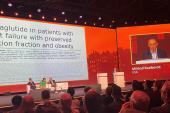Semaglutide Works Across LVEF Range: STEP-HFpEF Analysis
It’s reassuring to see efficacy at the higher end of the spectrum and safety at the lower end, Muthiah Vaduganathan says.

The clinical benefits of semaglutide (Wegovy; Novo Nordisk) in patients with the obesity phenotype of heart failure with preserved ejection fraction (HFpEF) don’t appear to be influenced by left ventricular ejection fraction, according to an analysis of the STEP-HFpEF trial.
Improvements in symptoms, physical limitations, exercise capacity, systemic inflammation, and body weight with the glucagon-like peptide-1 (GLP-1) receptor agonist versus placebo were consistent across three LVEF categories (45% to 49%, 50% to 59%, and 60% or greater), Javed Butler, MD (Baylor Scott & White Research Institute, Dallas, TX), reported recently at the Heart Failure Society of America (HFSA) 2023 meeting.
Moreover, there were no safety concerns at any level of LVEF, he said.
The findings, published simultaneously online in the Journal of the American College of Cardiology, support the use of semaglutide in patients with the obesity phenotype of HFpEF irrespective of baseline LVEF, Butler concluded.
Muthiah Vaduganathan, MD, who wrote an accompanying editorial in JACC with John Ostrominski, MD (both from Brigham and Women’s Hospital, Boston, MA), noted that several classes of heart failure therapies, including inhibitors of the renin-angiotensin-aldosterone system, have clinical benefits that vary based on ejection fraction, with lesser effects at the higher end of the LVEF spectrum. The sodium-glucose cotransporter 2 (SGLT2) inhibitors are the first heart failure therapies to have positive effects irrespective of LVEF, he told TCTMD.
“Understanding the ejection fraction-dependent effects [of semaglutide] is of really, really paramount importance because it has informed so much of what we’ve done so far in heart failure care,” Vaduganathan said.
In that context, “it’s reassuring, certainly, to see that the effects on health status are consistently seen across the ejection fraction spectrum, including at an EF above 60%,” he said.
Moreover, prior trials have suggested potential safety concerns with GLP-1 receptor agonists in patients with heart failure with reduced ejection fraction (HFrEF), so the lack of any safety issues among patients with the lowest EFs in STEP-HFpEF “also is certainly reassuring,” Vaduganathan said.
Digging Into STEP-HFpEF
STEP-HFpEF enrolled 529 patients (median age 69; 56.1% women) who had a body mass index of 30 kg/m2 or greater, were free from diabetes, had an LVEF of 45% or greater, and had at least one of the following characteristics: elevated LV filling pressures; elevated natriuretic peptide levels and structural echocardiographic abnormalities; or a heart failure hospitalization within the last year, an ongoing requirement for diuretics, and/or structural echocardiographic abnormalities. They were randomized to once-weekly subcutaneous semaglutide 2.4 mg or placebo on top of standard of care.
Overall, 85 patients had an LVEF of 45% to 49%, 215 had an LVEF of 50% to 59%, and 229 had an LVEF of 60% or higher. The proportion of women was greater, and NT-proBNP levels lower, at higher levels of LVEF. Those at the upper end of the range also were less likely to have a prior history of hospitalization for heart failure or to have atrial fibrillation or CAD.
As previously reported, semaglutide improved both primary endpoints of the trial through 1 year of follow-up—change in Kansas City Cardiomyopathy Questionnaire (KCCQ) clinical summary score and change in body weight. There was no heterogeneity across LVEF groups for either the change in KCCQ score (P = 0.56 for interaction) or weight loss (P = 0.08 for interaction).
Likewise, LVEF did not significantly influence the improvements in 6-minute walk test; a clinical hierarchical composite consisting of death, heart failure events, KCCQ score, and 6-minute walk test; C-reactive protein level; or NT-proBNP level (P = NS for all interactions).
During the trial, semaglutide came with lower rates of serious adverse events and cardiac serious adverse events compared with placebo, differences that were maintained in all three LVEF groups.
Is It the Weight Loss, or Something Else?
Discussing the results after Butler’s presentation, John McMurray, MD, PhD (University of Glasgow, Scotland), raised a question about whether the observed treatment benefits were due to weight loss alone or whether they could be attributed to some other effects of semaglutide as well.
If the latter, “[it] becomes very important because it means this treatment might do good things in nonobese patients, might do good things in patients with other types of heart failure,” McMurray said.
To look for clues about what’s providing the benefits, McMurray pointed to a prior randomized trial of diet and exercise in patients with HFpEF, which showed effects generally similar to those seen in STEP-HFpEF. That trial didn’t report what happened with NT-proBNP levels, but other studies have indicated that when patients with HFpEF lose weight, NT-proBNP levels go up. In STEP-HFpEF, on the other hand, NT-proBNP levels were significantly reduced with semaglutide, despite the weight loss.
“I think the reduction in NT-proBNP is the really interesting finding [in] this trial that may point to something more than just weight loss going on,” McMurray said.
As for the LVEF analysis, McMurray said it was important because of the questions around the safety of GLP-1 receptor agonists in patients with HFrEF, adding that the reduction in NT-proBNP seen even among patients with an EF of 45% to 49% “really is not consistent with harm occurring in patients in the lower part of the ejection fraction range. Now, it’s a small subgroup and clearly that needs some further exploration.”
Overall, McMurray called the trial “a very important and encouraging first step in understanding the use of GLP-1 receptor agonists in patients with heart failure,” adding, “We obviously need bigger, longer-term outcome trials.”
Vaduganathan also highlighted the need for additional research into the impact of GLP-1 receptor agonists in heart failure, noting that the STEP-HFpEF DM trial, which includes patients with type 2 diabetes, will provide additional information.
It’s important to point out, he said, that the STEP-HFpEF trials are designed to assess health status or quality of life and are not powered for harder endpoints. “While this still can be utilized and incorporated into our clinical practice as a patient-centric approach to improving their health status, improving their weight, hopefully improving other aspects of their health, I think we do need well-powered clinical trials to assess the use of GLP-1 receptor agonists in heart failure on traditional clinical outcomes like mortality and hospitalizations for heart failure,” Vaduganathan said.
He also noted that there are additional incretin-based drugs in the pipeline, and it’s possible that these will have even greater benefits than semaglutide in patients with HFpEF.
Todd Neale is the Associate News Editor for TCTMD and a Senior Medical Journalist. He got his start in journalism at …
Read Full BioSources
Butler J, Abildstrøm SZ, Borlaug BA, et al. Semaglutide effects according to ejection fraction in heart failure with preserved ejection fraction and obesity. J Am Coll Cardiol. 2023;Epub ahead of print.
Vaduganathan M, Ostrominski JW. Glucagon-like peptide-1 receptor agonists in heart failure: STEPping across the ejection fraction divide. J Am Coll Cardiol. 2023;Epub ahead of print.
Disclosures
- STEP-HFpEF was sponsored by Novo Nordisk.
- Butler reports consulting for Abbott, American Regent, Amgen, Applied Therapeutics, AstraZeneca, Bayer, Boehringer Ingelheim, Bristol Myers Squibb, Cardiac Dimension, Cardior, CVRx, Cytokinetics, Edwards, Element Science, Eli Lilly, Innolife, Impulse Dynamics, Imbria, Inventiva, Lexicon, LivaNova, Janssen Pharmaceuticals, Medtronic, Merck, Occlutech, Novartis, Novo Nordisk, Pfizer, Pharmacosmos, PharmaIN Corporation, Roche, Sequana, SQ Innovation, and Vifor Pharma and speaking for AstraZeneca, Bayer, Boehringer Ingelheim, Impulse Dynamics, Merck, and Vifor Pharma.
- McMurray reports payments to his institution for work on clinical trials, consulting, and other activities from Alnylam, Amgen, AstraZeneca, Bayer, Boehringer Ingelheim, BMS, Cardurion, Cytokinetics, Dal-Cor, GSK, lonis, KBP Biosciences, Novartis, Pfizer, and Theracos, as well as personal payments from Abbott, Alkem Metabolics, AstraZeneca, Boehringer Ingelheim, Cardurion, Eris Lifesciences, Hikma, lonis, Lupin, Novartis, ProAdWise Communications, and Sun Pharmaceuticals.
- Vaduganathan reports having received research grant support, served on advisory boards, or had speaker engagements with American Regent, Amgen, AstraZeneca, Bayer AG, Baxter Healthcare, Boehringer Ingelheim, Chiesi, Cytokinetics, Lexicon Pharmaceuticals, Merck, Novartis, Novo Nordisk, Pharmacosmos, Relypsa, Roche Diagnostics, Sanofi, and Tricog Health and participating on clinical trial committees for studies sponsored by AstraZeneca, Galmed, Novartis, Bayer AG, Occlutech, and Impulse Dynamics.
- Ostrominski reports no relevant conflicts of interest.





Comments